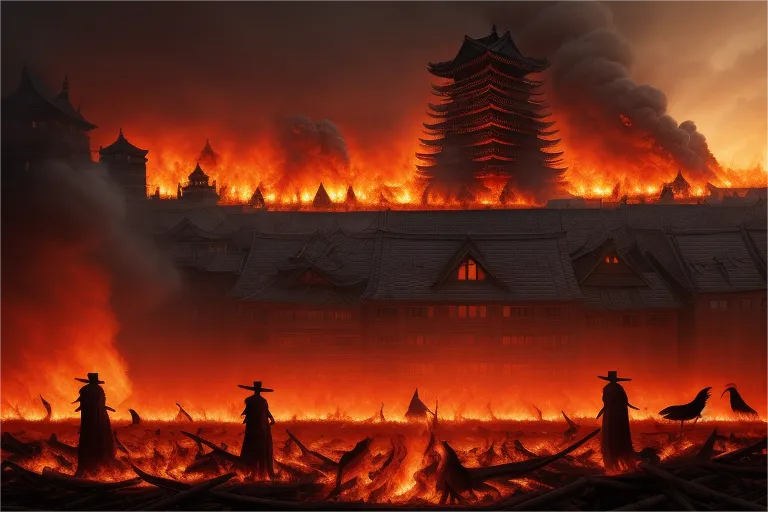The Great Fire of Meireki in 1657 devastated Edo (Tokyo), reshaping its urban planning and leaving a lasting mark on Japan’s history.

What Was the Great Fire of Meireki?
The Great Fire of Meireki, which raged from March 2-4, 1657, began as a seemingly minor incident in the Hongō district of Edo. Historical records suggest that the fire originated from a small temple where a ceremonial burning of worn-out kimonos went awry. Strong winds quickly transformed this humble fire into an unstoppable inferno that would ravage the city for three days.
The timing couldn’t have been worse – Edo was experiencing an unusually dry winter, and powerful seasonal winds helped spread the flames rapidly through the densely packed wooden buildings that characterized the city. The fire’s fury was so intense that it created its own weather system, generating fire tornados that further accelerated the destruction.
The Destruction and Casualties
The scale of devastation wrought by the Meireki Fire was unprecedented. The inferno consumed approximately 60-70% of Edo’s urban area, reducing much of the city to ashes. The death toll reached a staggering 100,000 people, making it one of the deadliest urban disasters of pre-modern Japan.
The fire destroyed numerous architectural treasures, including large portions of Edo Castle, hundreds of temples and shrines, and countless residential areas. Many of the city’s bridges, essential for evacuation, were also consumed by the flames, trapping residents and contributing to the high death toll. The destruction was so complete that contemporary accounts describe the city as “a scorched plain as far as the eye could see.”
The Impact on Edo’s Urban Development
The Great Fire of Meireki became a catalyst for revolutionary changes in Japanese urban planning. In its aftermath, the Tokugawa shogunate implemented sweeping reforms to prevent future disasters of this magnitude. New building codes mandated wider streets, designated fire breaks, and the strategic placement of fire-resistant storehouses throughout the city.
The government introduced strict regulations on building materials and construction methods. Neighborhoods were reorganized to include mandatory fire-prevention features such as water storage facilities and fire watchtowers. The height of buildings was restricted to reduce fire spread, and certain types of buildings were required to have thick earthen walls – a feature that would become characteristic of traditional Japanese architecture.
Social and Economic Aftermath
The fire’s impact extended far beyond physical destruction, profoundly affecting Edo’s social and economic fabric. Thousands of families were left homeless, and the city’s commercial activities ground to a halt. The shogunate responded by organizing massive relief efforts, distributing food and building materials to affected residents.
The disaster led to significant social reorganization as neighborhoods were rebuilt. The government used this opportunity to reorganize the city’s social structure, creating more defined districts for different social classes. This reorganization would influence Edo’s social dynamics for generations to come.
Cultural Legacy of the Great Fire
The Great Fire of Meireki has left an enduring imprint on Japanese culture. The disaster features prominently in ukiyo-e prints, literature, and oral traditions from the period. Stories of heroism, tragedy, and renewal during the fire became part of Japan’s cultural narrative about disaster and recovery.
The event gave rise to numerous fire-prevention festivals and ceremonies that continue today. The disaster also influenced Japanese literature and art, with many works depicting the fire’s destruction and the subsequent rebuilding of Edo. These cultural artifacts provide valuable insights into how Japanese society processed and memorialized this catastrophic event.
Conclusion
The Great Fire of Meireki remains a pivotal moment in Japanese history, marking a turning point in urban development and disaster prevention. Its legacy lives on in modern Tokyo’s fire prevention systems, building codes, and urban planning principles. While the physical scars have long since healed, the lessons learned from this catastrophic event continue to influence how Japanese cities approach disaster preparedness and urban safety.
The fire serves as a powerful reminder of both human vulnerability to natural disasters and the remarkable resilience of communities in their aftermath. From its ashes arose not just a rebuilt city, but a new approach to urban living that would help shape the development of one of the world’s greatest metropolises.
More articles: David Hahn: The Radioactive Boy Scout
